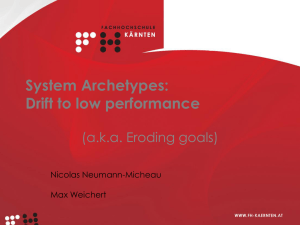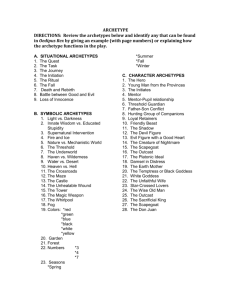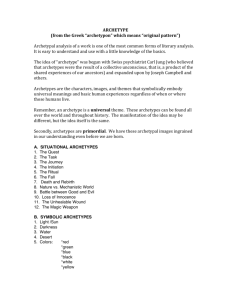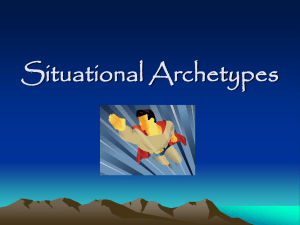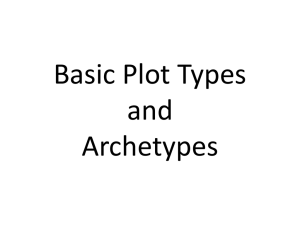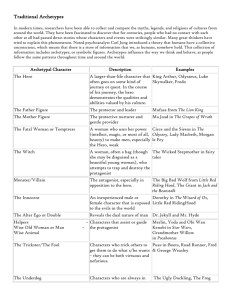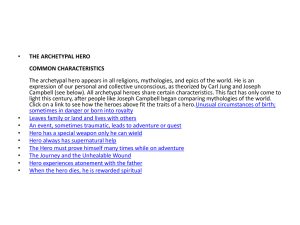Archetypes Notes
advertisement
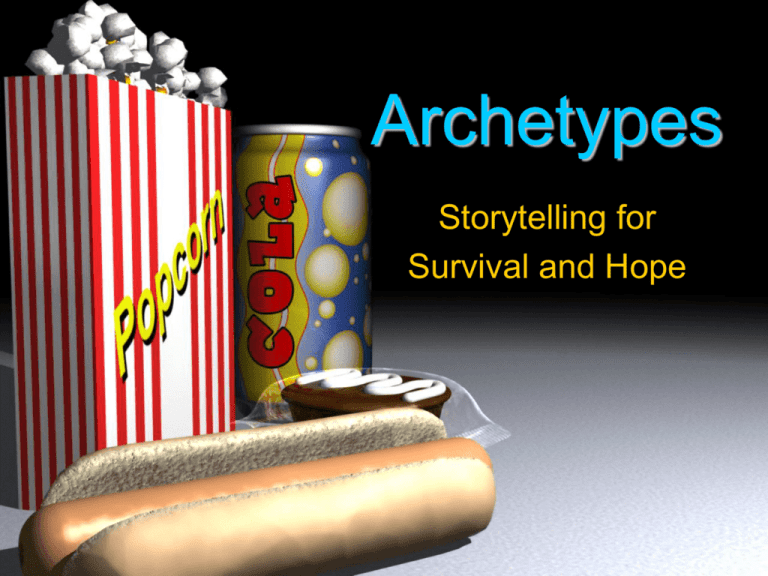
Archetypes Storytelling for Survival and Hope How many stories do you encounter daily? • Think about the number of stories you encounter daily either reading, viewing, or listening. This would include all of the following categories: -books, short stories, newspaper stories, movies, sitcoms, tv shows, video games, news reports, magazine stories, music. • Write down this number in your notes, as well as what categories apply to you. • Write down what percentage of the stories you encounter are fictional. Do you agree with the following statements? • Storytelling is essential for the survival of humanity and provides hope for humanity. • Without stories, mankind would slowly go mad and become suicidal. Storytelling for Survival and Hope Why do we need stories? •To explain natural phenomenon such as great floods and the creation of the world •To answer such questions such as why we are born and why we die •To help us escape reality by entering a world where the good guy wins, the forces of evil are defeated, and love conquers all •To help define the roles of good and evil such as the hero and the villain so that we might recognize them in reality What are archetypes? •They are the basic building blocks of stories that all writers use to create a world to which readers can escape. •Without communicating about archetypes, all cultures around the world use them to build their stories. This is called the Collective Unconscious (term coined by Carl Jung). •Examples of archetypes are: the hero, the damsel in distress, the battle between good and evil, etc. http://www.chatafrikarticles.co m/articles/1211/1/CARL-GJUNG/Page1.html Recognizing Archetypes ______ upon a ______, a _________ on a ________ horse set out on a ___________ to rescue a __________ ____ ___________ from an ______ ______________. http://www.animationfactory.com Recognizing Archetypes The _______ who is in _____ with the ____________, carries her after she has ______________. The ____ _________ lumbered back to his ______ master. http://www.animationfactory.com Recognizing Archetypes The ____________ has caught the ________. Decisions between ______ and _______ are not always easy. http://www.animationfactory.com Character Archetypes •THE HERO—mother is sometimes a virgin, circumstances of birth are unusual, some attempt is made at birth to kill him; raised by foster parents, returns to his kingdom to right wrongs, marries a princess, becomes king, meets a mysterious death, body is burned rather than buried •YOUNG MAN FROM THE PROVINCES—hero is taken away as a young man and raised by strangers; when he returns home, he can view problems objectively and can solve them easier •THE INITIATE—young heroes or heroines who go through training; usually innocent and wear white •MENTOR—teacher or counselor to the initiate; often are father or mother figures to the hero or heroine •FATHER-SON CONFLICT—father and son are separated and do not meet until the son is an adult; often the mentor is loved and respected more Character Archetypes •HUNTING GROUP OF COMPANIONS— loyal companions willing to face any number of dangers to be together •LOYAL RETAINERS—somewhat like servants to the hero who are heroic themselves; their duty is to protect the hero and reflect the nobility of the hero; they are expendable •FRIENDLY BEAST—a beast on the side of the hero shows that nature sides most often with the forces of good Character Archetypes •DEVIL FIGURE—evil incarnate; offers worldly goods, fame, or knowledge to the hero in exchange for possession of the soul •EVIL FIGURE WITH GOOD HEART— redeemable evil figure saved by the nobility or love of the hero. •SCAPEGOAT—animal or human who is unjustly held responsible for others’ sins; sacrificed but they often become more powerful force dead than alive Character Archetypes •OUTCAST—figure banished from a social group for some crime against his fellow man (could be falsely accused of a crime or could choose to banish himself from guilt) •EARTHMOTHER—offers spiritual and emotional nourishment to those she meets; shown in earth colors and has large breasts and hips symbolic of her childbearing capabilities •TEMPTRESS—sensuous beauty; brings about the hero’s downfall because he is physically attracted to her Character Archetypes •PLATONIC IDEAL—female figure who provides intellectual stimulation for the hero; he is not physically attracted to her •DAMSEL IN DISTRESS--a female character who needs the hero to rescue her from either emotional or physical danger •STAR-CROSSED LOVERS—two lovers forbidden to be together because of the rules of society or family; often ends tragically •CREATURE OF NIGHTMARE—animal or creature disfigured or mutated; monsters who are the antagonists in the story Situational Archetypes •THE QUEST—search for someone or some object, which when it is found and brought back will restore life to a wasted land, the desolation of which is shown by a leader’s illness and disability •THE TASK—to save the kingdom, to win the fair lady, to identify himself so that he may assume his rightful position, the hero must perform some nearly superhuman deed. Situational Archetypes •THE INITIATION—this usually takes the form of an initiation into adult life. The adolescent comes into his/her maturity with new awareness and problems along with a new hope for the community. This awakening is often the climax of the story. Situational Archetypes •THE JOURNEY—the hero goes in search of some truth or information to restore life to the kingdom; he must descend into a real or psychological hell and is forced to discover the blackest truths quite often concerning his faults; once the hero is at his lowest point, he must accept personal responsibility to return to the world of the living; this could also appear as a group of isolated people (trapped on a boat, bus, island) to represent society Situational Archetypes •THE FALL—describes a descent from a higher to a lower state of being. The experience involves a defilement and/or a loss of innocence and bliss. The fall is often accompanied by expulsion from a kind of paradise as a penalty for disobedience and moral transgression. •DEATH AND REBIRTH—grows out of a parallel between the cycle of nature and the cycle of life. Thus, morning and springtime represent birth, youth, or rebirth; evening and winter suggest old age or death. •NATURE VS. MECHANISTIC WORLD—Nature is good while technology and society are often evil. Situational Archetypes •BATTLE BETWEEN GOOD AND EVIL— Obviously the battle between two primal forces. Mankind shows eternal optimism in the continual portrayal of good triumphing over evil despite great odds. •THE UNHEALABLE WOUND—The wound is either physical or psychological and cannot be healed fully. This wound also indicates a loss of innocence. These wounds always ache and drive the sufferer to desperate measures. •THE RITUAL—The actual ceremonies the initiate experiences that will mark his rite of passage into another state (weddings, funerals) Symbolic Archetypes •LIGHT VS. DARKNESS—light suggests hope, renewal, or intellectual illumination; darkness suggests the unknown, ignorance, or despair. •WATER VS. DESERT—water is necessary to life and growth and so it appears as a birth or rebirth symbol; the appearance of rain in a work can suggest spiritual birth or rebirth; characters who live in the desert are often “dead” to morals or the “good side” Symbolic Archetypes •HEAVEN VS. HELL—gods live in the skies or mountaintops; evil forces live in the bowels of the earth •INNATE WISDOM VS EDUCATED STUPIDITY—uneducated characters can often be wise using their common sense while some very educated characters have no common sense Symbolic Archetypes •SUPERNATURAL INTERVENTION—the gods most often intervene on the side of the hero to assist him in his quest •HAVEN VS. WILDERNESS—for the hero, places of safety are required for time to regain health and resources; these hideouts are often in unusual places Symbolic Archetypes •FIRE VS. ICE—fire can represent knowledge, light, life, and rebirth while ice can represent ignorance, darkness, sterility, and death •MAGIC WEAPON—some object used to fight the forces of evil that has magical properties
